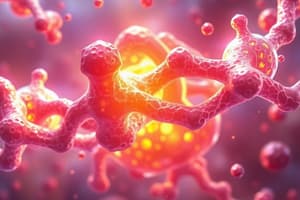Podcast
Questions and Answers
What is an enzyme?
What is an enzyme?
An organic compound that acts as a catalyst for a biochemical reaction and increases the rate of reaction without being changed in the process.
Which of the following is NOT a feature of enzymes?
Which of the following is NOT a feature of enzymes?
- They can be changed in the process. (correct)
- They are water-soluble.
- They are very specific.
- They enhance reaction rates.
What is a metalloenzyme?
What is a metalloenzyme?
An enzyme that is bound tightly to a metal ion and does not dissociate even after extensive purification.
An apoenzyme is the inactive form of an enzyme that requires a cofactor to become active.
An apoenzyme is the inactive form of an enzyme that requires a cofactor to become active.
What is the reactant in an enzyme-catalyzed reaction called?
What is the reactant in an enzyme-catalyzed reaction called?
Which of the following suffixes typically identifies an enzyme?
Which of the following suffixes typically identifies an enzyme?
What type of reaction does a hydrolase enzyme catalyze?
What type of reaction does a hydrolase enzyme catalyze?
What type of enzyme catalyzes the transfer of a functional group from one molecule to another?
What type of enzyme catalyzes the transfer of a functional group from one molecule to another?
Which of the following is NOT a subclass of transferases?
Which of the following is NOT a subclass of transferases?
Flashcards
Enzyme
Enzyme
An organic compound that acts as a catalyst in biochemical reactions, increasing the reaction rate without being consumed or altered.
Coenzyme
Coenzyme
A small organic molecule that acts as a cofactor to assist an enzyme in its catalytic function.
Cofactor
Cofactor
A nonprotein component needed by certain enzymes for function. Can be an inorganic ion or organic molecule.
Apoenzyme
Apoenzyme
Signup and view all the flashcards
Holoenzyme
Holoenzyme
Signup and view all the flashcards
Proenzyme (Zymogen)
Proenzyme (Zymogen)
Signup and view all the flashcards
Active Site
Active Site
Signup and view all the flashcards
Substrate
Substrate
Signup and view all the flashcards
Catalysis
Catalysis
Signup and view all the flashcards
Specificity
Specificity
Signup and view all the flashcards
Hydrolase
Hydrolase
Signup and view all the flashcards
Oxidoreductase
Oxidoreductase
Signup and view all the flashcards
Transferase
Transferase
Signup and view all the flashcards
Lyase
Lyase
Signup and view all the flashcards
Isomerase
Isomerase
Signup and view all the flashcards
Ligase
Ligase
Signup and view all the flashcards
Enzyme Classes
Enzyme Classes
Signup and view all the flashcards
Enzyme Activity Regulation
Enzyme Activity Regulation
Signup and view all the flashcards
Enzyme Location
Enzyme Location
Signup and view all the flashcards
Study Notes
Enzymes
- Enzymes are biological catalysts that speed up chemical reactions without being consumed in the process.
- They are typically proteins, but some RNA molecules can also act as enzymes, known as ribozymes.
- Enzymes bind to specific molecules called substrates, facilitating their conversion into products.
- The rate of an enzyme-catalyzed reaction is higher than the rate of the uncatalyzed reaction.
Enzyme Features
- Enzymes are highly specific, typically catalyzing only one or a small number of reactions.
- Enzymes are subject to regulation, allowing cells to control their metabolic processes.
- Enzymes are affected by temperature and pH, having optimal conditions for activity.
- Enzymes do not change the equilibrium constant of a reaction.
- Enzymes are reusable, participating in multiple rounds of catalysis.
Metalloenzymes
- Metalloenzymes are enzymes that require a metal ion for their activity.
- The metal ion acts as a cofactor, assisting in the catalytic process.
- Examples of metalloenzymes include:
- Cytochrome oxidase: contains copper and iron ions
- Carbonic anhydrase: contains zinc ions
Apoenzymes and Cofactors
- Apoenzymes are the inactive form of an enzyme that requires a cofactor to become active.
- Cofactors can be inorganic ions (like metal ions) or organic molecules (like vitamins).
- Holoenzyme is the fully active enzyme containing both the apoenzyme and the cofactor.
Substrate
- The reactant in an enzyme-catalyzed reaction is called the substrate.
- The substrate binds to the enzyme's active site, forming an enzyme-substrate complex.
Enzyme Nomenclature
- Many enzymes end with the suffix -ase.
- Examples include:
- Lactase: breaks down lactose
- Protease: breaks down proteins
Hydrolases
- Hydrolases are enzymes that catalyze the hydrolysis of a chemical bond, usually by adding water.
- They break down larger molecules into smaller ones.
- Examples include:
- Lipase: breaks down lipids
- Amylase: breaks down carbohydrates
Transferases
- Transferases catalyze the transfer of a functional group (like a phosphate group) from one molecule to another.
- Examples include:
- Kinases: transfer a phosphate group
- Glycosyltransferases: transfer a sugar molecule
- Methyltransferases: transfer a methyl group
- Dehydrogenases are a subclass of transferases that transfer hydrogen ions and electrons.
Subclasses of Transferases
-
Phosphotransferases: transfer phosphate groups
-
Glycosyltransferases: transfer sugar molecules
-
Methyltransferases: transfer methyl groups
-
Dehydrogenases: transfer electrons and hydrogen ions
-
Acyltransferases: transfer acyl groups
-
Isomerases are NOT a subclass of transferases. They catalyze the rearrangement of atoms within a molecule, converting one isomer to another.
Studying That Suits You
Use AI to generate personalized quizzes and flashcards to suit your learning preferences.




